Ever since RockShox brought its Bottomless Token system to market in 2014 alongside the re-release of the Pike, more riders have been considering air spring volume as a legitimate way of tuning their suspension.
Fast-forward to 2018, and pretty much every major fork manufacturer has some way of easily adjusting air spring volume to alter how progressive or linear their suspension feels.
Adding to that list, Formula’s Neopos is a product that’s also designed to affect volume and the behaviour of the air spring. This however, ain’t no any ordinary volume spacer.
Latest Singletrack Merch
Buying and wearing our sustainable merch is another great way to support Singletrack
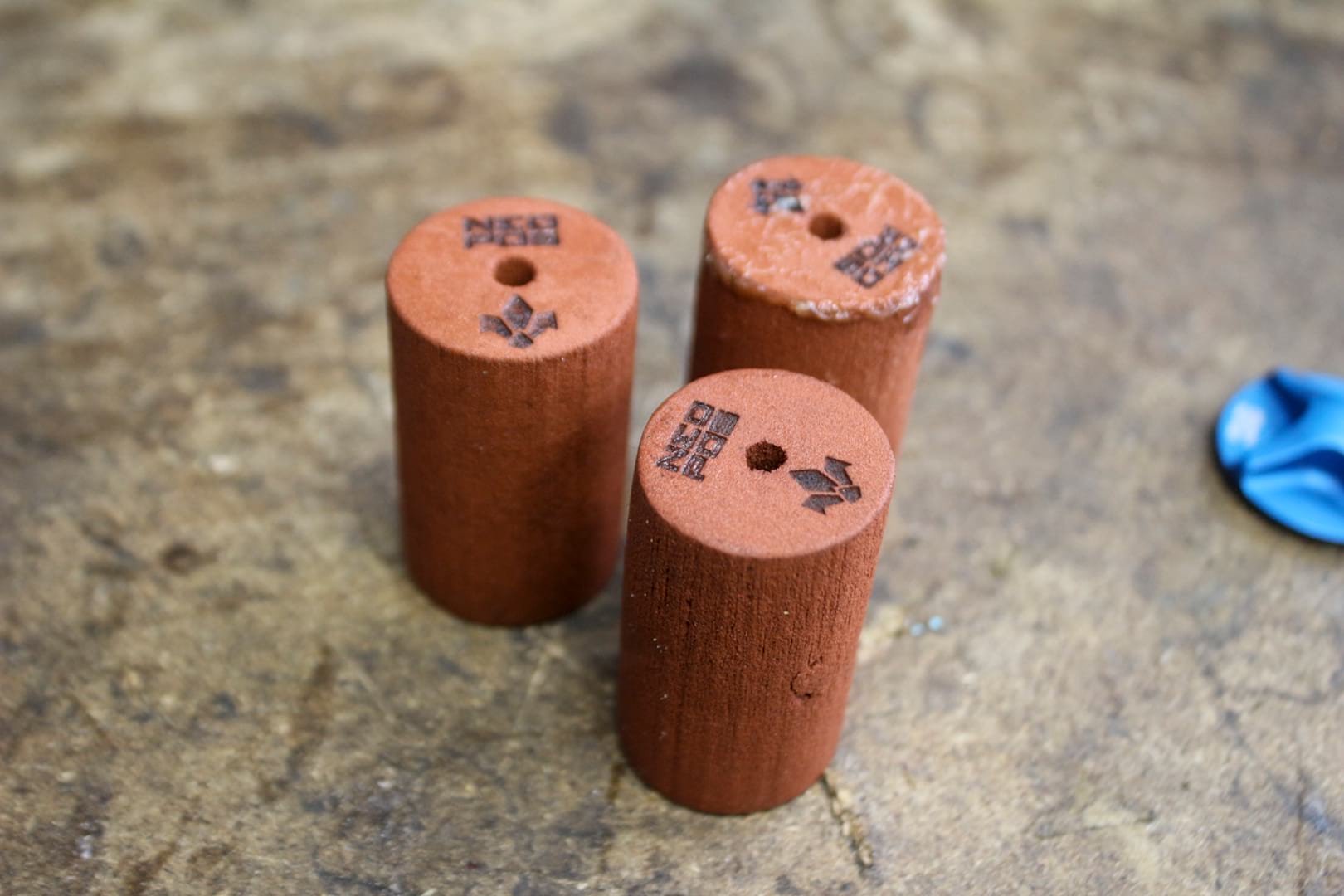
I first tested the Neopos volume spacer earlier this year at Bike Connection in Les Gets. I had it fitted to Formula’s new Selva R enduro fork, and was able to perform back-to-back runs at the bikepark to get a feel for what the spacer was doing inside the air spring. You can read about my initial experience with the new Selva R fork and the Neopos spacer here.
I scored a few Neopos spacers at Bike Connection to take home with me, and since then we’ve tested them in a variety of air-sprung forks ranging from 120mm to 170mm of travel. We’ve run the spacer inside a Formula 35, a Selva, a couple of Fox 36’s and a 34 Step-Cast, as well as an X-Fusion McQueen.
And the results have been interesting to say the least.

So What Is It?
Formula’s Neopos is a volume spacer, and like those from RockShox and Fox, it’s designed to sit inside the fork’s air spring. This spacer isn’t made of rigid plastic though. Instead, it’s made from a squishy, compressible foam.
Formula won’t tell us exactly what material the Neopos spacer is made from, but we do know that the spacers are manufactured in Italy by a company that specialises in closed-cell foam and nanotechnology. The foam is aerated with loads of tiny air bubbles throughout, and it’s these closed-cell air bubbles that allow the spacer to compress under pressure, before springing back to its original shape.
Hold Up Sunshine, We’ve Seen Elastomers In Forks Before!
Allow me to clarify – Neopos is not an elastomer, and shares absolutely nothing in common with the MCU dampers used in suspension forks from last century. Neopos sits inside the air spring chamber, and is only designed to compress by air pressure. Its function is not mechanical – nothing presses on it, and it is definitely not like some kind of physical bump-stop.

Righto Then, How Does It Work?
Up until now, Formula forks have not used volume spacers. Instead, users have been able to add or subtract oil from inside the main air chamber to alter the air volume – a messy and somewhat faffy process. The Neopos spacer has emerged as a cleaner and simpler solution for altering a Formula fork’s spring rate.
Just like a regular volume spacer, Neopos is designed to take up volume inside the air spring. You can use up to three of them, and the more you use the less air volume you have, and the more progressive your fork will feel. So far, so normal.
Here’s where it gets interesting. Unlike a rigid volume spacer, the Neopos spacer compresses as air pressure increases. So as you go through the travel and air pressure builds inside the chamber, the Neopos spacer physically gets smaller in size.
And herein lies its magic:
The effect of this compressible spacer can be described as an ‘easing out’ of the spring curve. Most air springs tend to have a very steep ramp-up in the last portion of the travel, where the internal air pressure builds rapidly. This is good for bottom-out support, but it can make the last third of the travel feel harsh and less usable.
Because the Neopos spacer gets smaller as you push deeper into the travel though, it’s able to give all of that building air pressure a little extra breathing room. The gentler increase in air pressure results in a smoother and less harsh ramp-up at the end of the travel.
To put it another way, the Neopos spacer helps to ‘linearise’ the air spring curve. It doesn’t make it completely linear like a coil spring, but it does produce a slightly flatter spring curve.

Unexpected Results
Despite its apparent simplicity though, there’s been a lot of testing since the original idea behind Neopos was born in 2011.
Err, seven years to make a squishy bit of foam?
“So many!” exclaims Formula’s Marketing Manager, Vittorio Platania, when I ask him what other materials they tested. “We had to find the exact behaviour for both compression and expansion time, then the right volume and size, and then we tested it with so many different lubrication oils. A lot of research.”
During this testing process to find the right material and properties they were after, Formula’s team discovered some unexpected effects. The compressible volume spacer was doing what they hoped, but something else was going on.
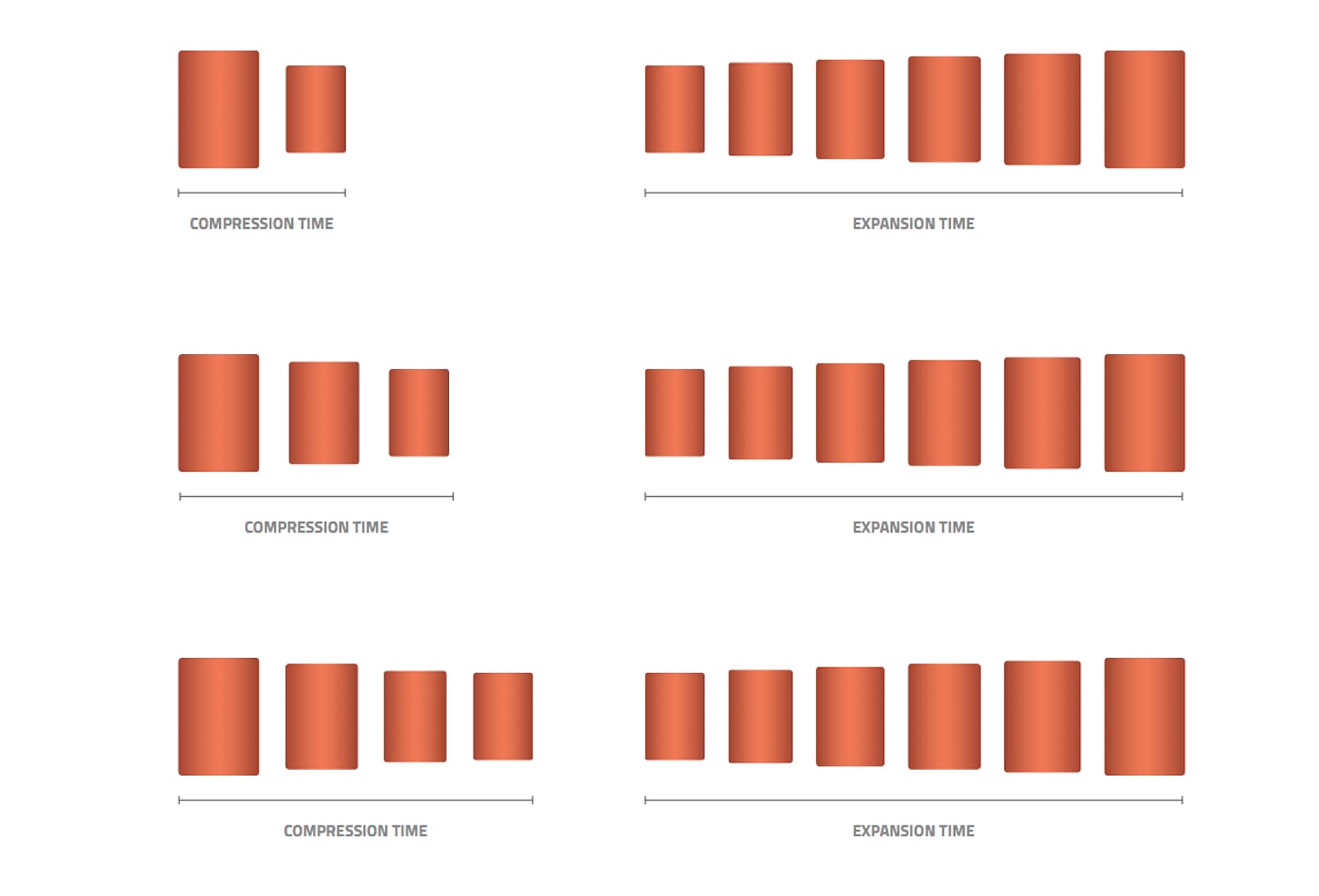
“The science behind the Neopos was very new for us”, explains Vittorio. “We discovered something that we were not expecting at the first step. We spend a lot of time, since 2011, to understand the physics behind the Neopos and to develop the right product for MTB use”.
What Vittorio is referring to here is how the Neopos spacer actually changes the way air behaves inside the air spring.
To help visualise this, picture a coil spring on its own. When you compress a coil spring, its action is consistent and linear. Its response is also exactly the same regardless of how quickly you try to compress it. So it’ll compress the same amount whether you apply a force at low speed, or high speed.
In comparison, the response of a traditional air spring isn’t constant, because the force required to compress the air spring is velocity dependent. Try to compress it really quickly, and you’ll need more force to achieve the same amount of travel.
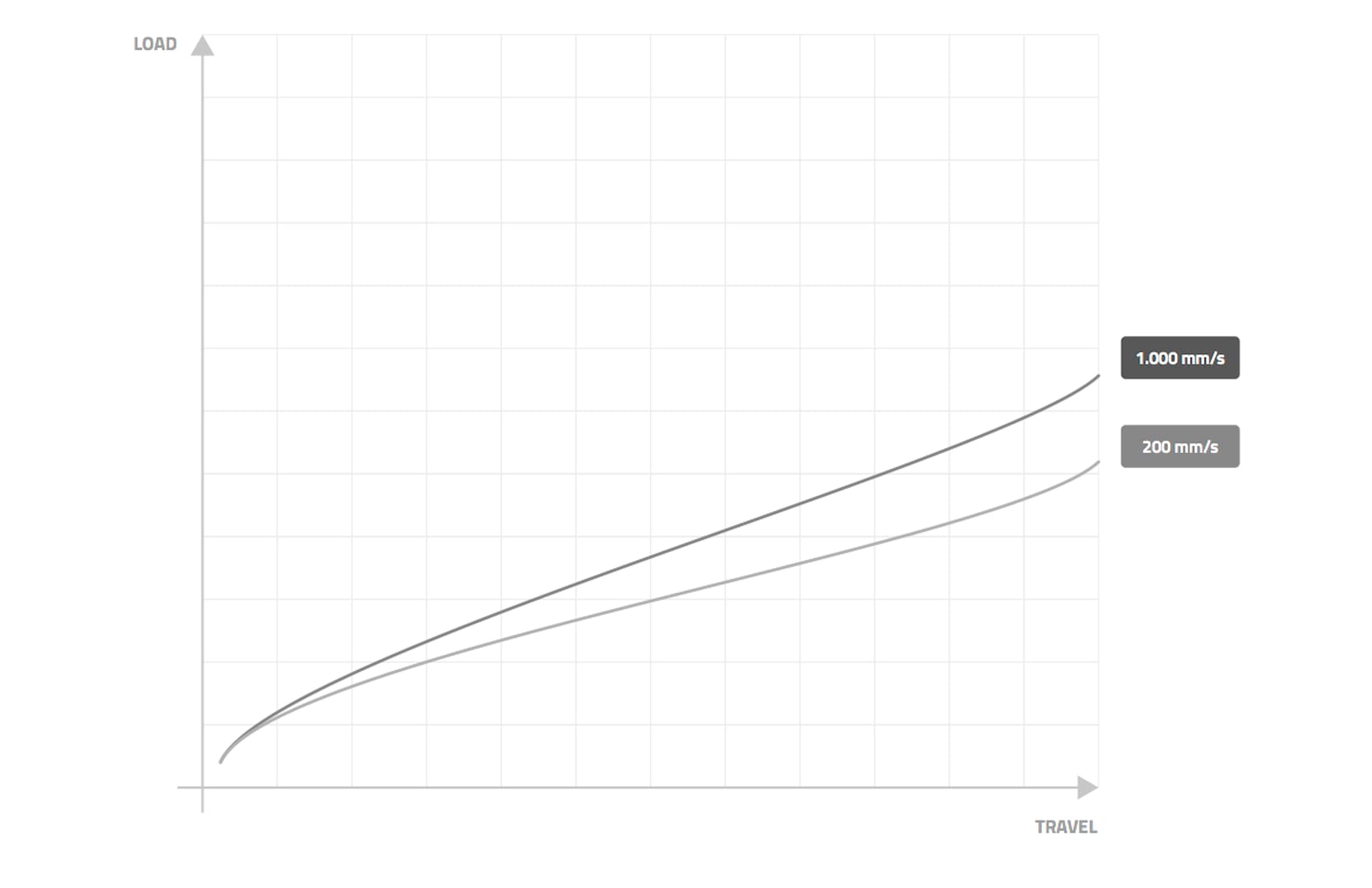
When you add a Neopos spacer into the mix though, you’ve got something soft and squidgy in there that changes its compression rate depending on the force exerted on it. Put a small amount of pressure on it, and it compresses slowly. Put a load of pressure on it, and it compresses quickly. The key attribute however, is its expansion time. No matter how hard and fast that initial impact, the Neopos spacer will always rebound at the same rate – like a coil spring.
It’s this constant rebound characteristic that goes some way to neutralising the speed-sensitive nature of an air-sprung fork. Again, it doesn’t match that of a coil spring, but according to Formula, the Neopos spacer will allow the fork’s action to be more consistent in its response, regardless of impact speed.
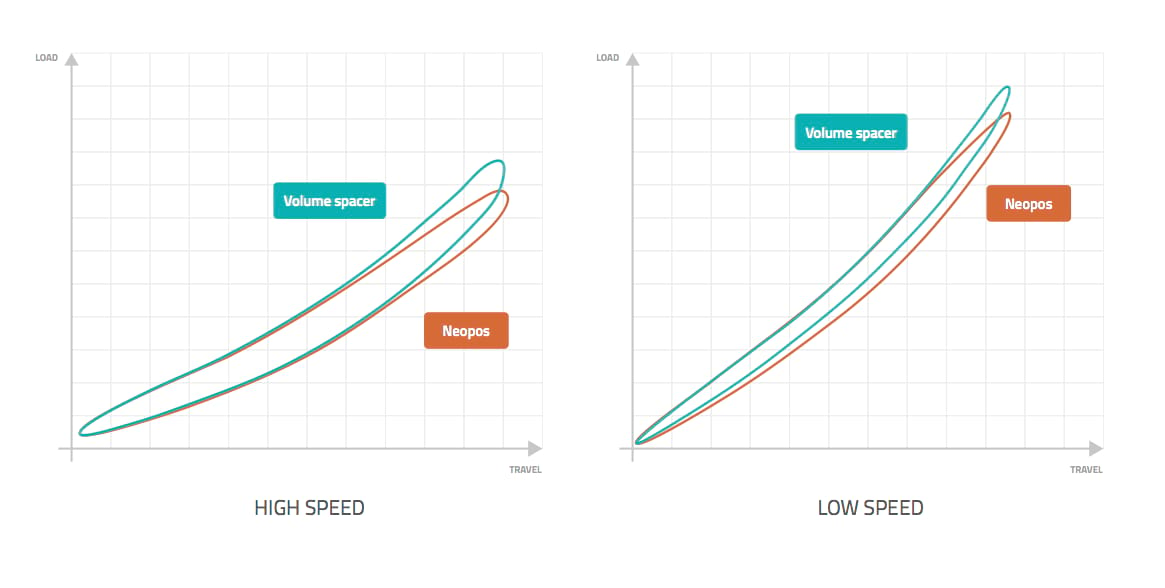
I won’t admit to fully understanding the science behind what the Neopos spacer does inside a fork’s air spring. For those interested though, you can read more about the theory of what’s going on here. What I can say is that on the trail, it works.
Hold Up – Here’s The Boring Warranty Bit
Formula introduced Neopos earlier this year as an upgrade solution for its existing forks. The new Selva R will come supplied with a Neopos spacer inside its air spring, but owners of existing Formula 33, 35, Selva and Nero forks will be able to buy a set of three Neopos spacers aftermarket for €29 and use it in their current fork.
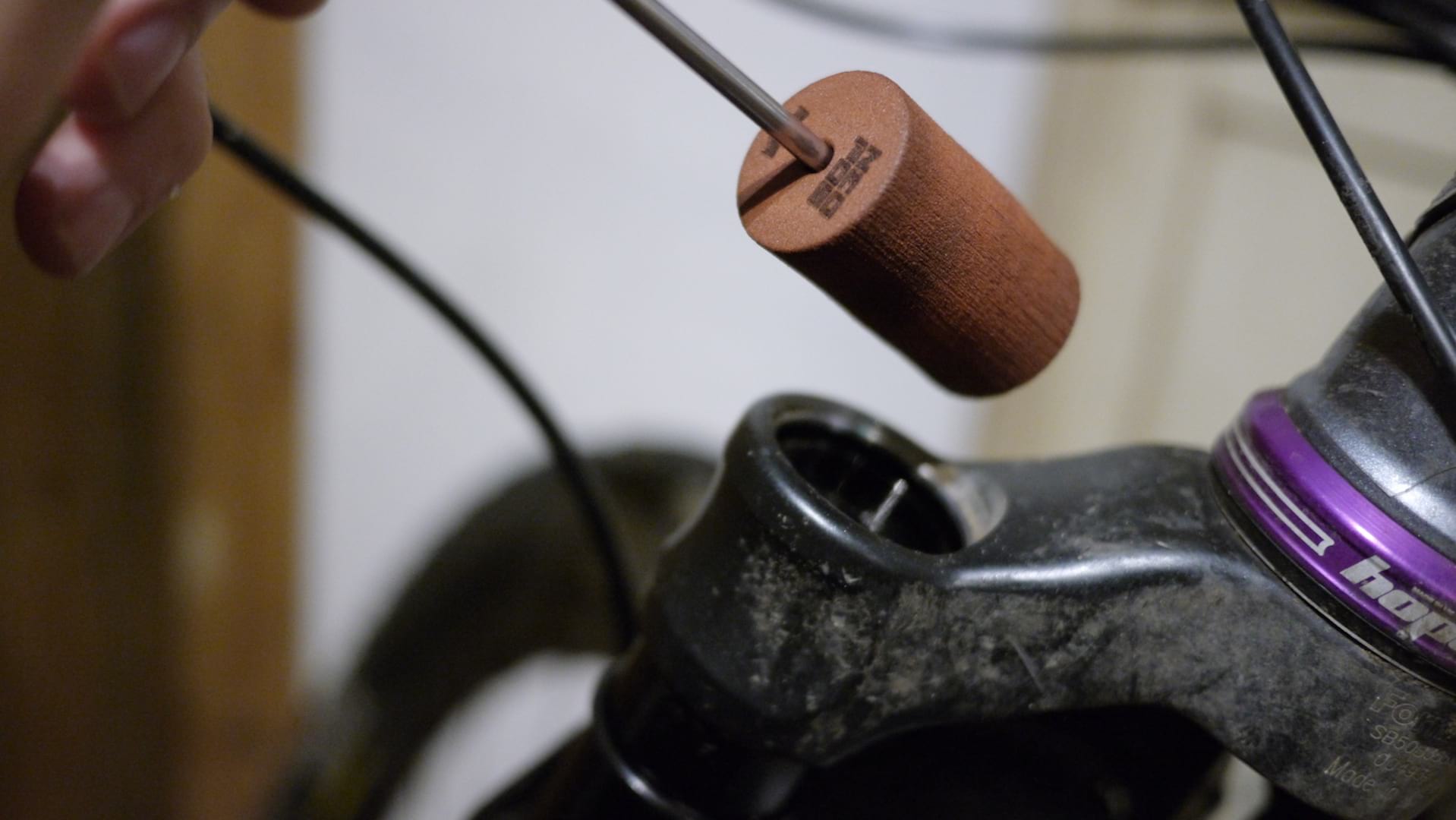
Though the Neopos spacer has been engineered specifically to work with Formula’s own forks, theoretically you can slot it into any air-sprung fork with 33mm or bigger stanchions. Of course Formula is very keen to stipulate that it doesn’t recommend this, partly because it hasn’t tested the Neopos spacer in other brand’s forks, and partly because those other brands aren’t likely to be pleased that you’re putting weird squidgy bits inside their product.
Though I’ve not experienced any damage or wrongdoing caused by using the Neopos spacer in the forks we’ve tested, it goes without saying that just like fitting an MRP Ramp Control cartridge or a Push ACS3 Conversion Kit, modifying your fork in any way will void the original manufacturer’s warranty. Got it?
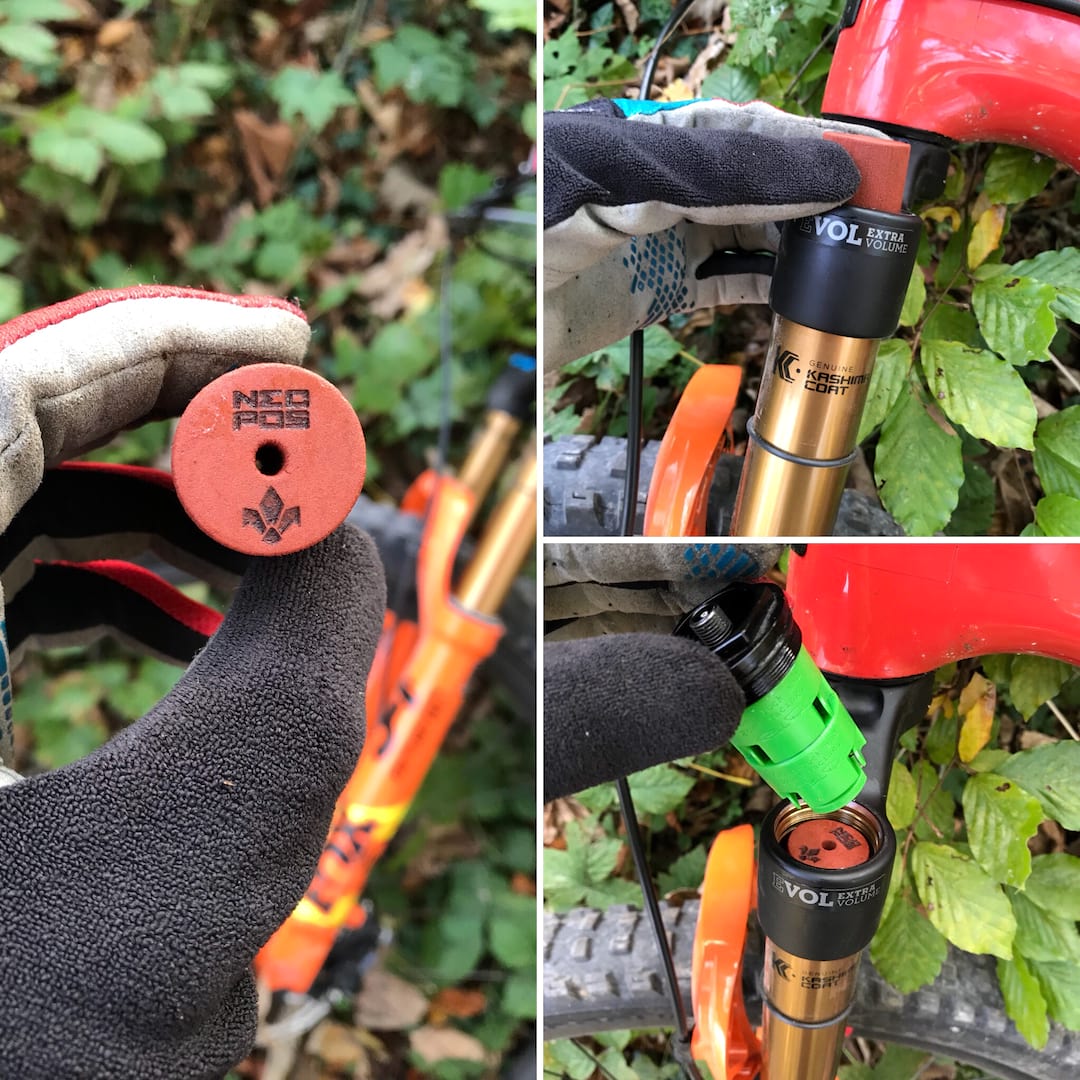
Installation
Fitting the Neopos spacer is as easy as it gets. After depressurising the air spring, you simply unthread the top cap and plop the Neopos spacer directly inside the air chamber. You don’t need to thread it into the top cap like you would with a normal plastic volume spacer, and it doesn’t attach to anything inside the fork. Although if floats around in there, it’s so light and soft that there is zero chance of you noticing it.
On The Trail
Having tested the Neopos spacer in a variety of forks, I can say that it’s made an improvement each time. The effect isn’t always the same though. For example, in the 120mm travel Fox 34 Step-Cast, which is already a spectacular fork, the difference was there, but more subtle. In the X-Fusion McQueen HLR fork that came fitted to the Cotic SolarisMAX I recently tested, the Neopos made a helluva difference.
Despite being packed with adjustments, including low and high-speed compression dials, the McQueen was a fork that I struggled to get feeling right. It felt notchy and too linear out of the box, but although it smoothed out a little as the bushings bedded in over time, it just never felt as good as an equivalent Pike.
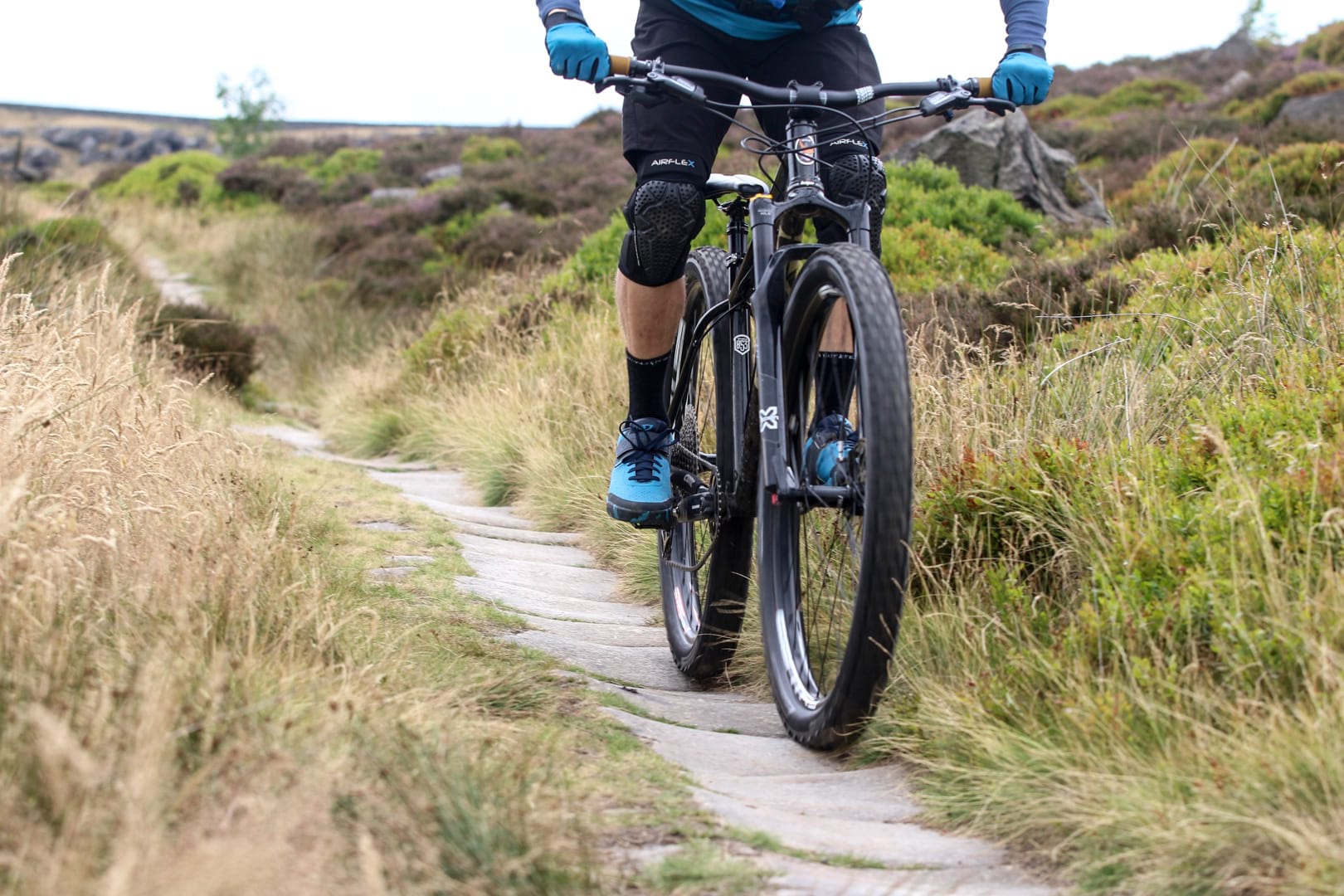
As soon as the Neopos spacer was added to the air spring though, the McQueen came alive with noticeably improved suppleness and small-bump sensitivity – kind of like it had been freshly serviced with new seals and oil. Even with exactly the same air pressure inside, it just seemed to react with more fluidity on high-speed chatter. Also, because the Neopos spacer does shrink the air volume, the last portion of the McQueen’s travel experienced a modest boost in progression to prevent me from hitting full straps too early. All-round, it was a significant improvement.
In our collective experience though, I would say the effect of the Neopos spacer is more noticeable in longer travel applications, where you’re typically riding on gnarlier terrain at higher speeds.
Case in point was the 170mm travel Fox 36 on the new Scott Ransom. This was another fork that I wasn’t 100% happy with out of the box – I either had the right sag amount and the fork felt a little harsh, or I had the fork feeling smooth and there was too much sag. On top of that I wasn’t really getting full travel out of it either, even though there were zero volume spacers inside.
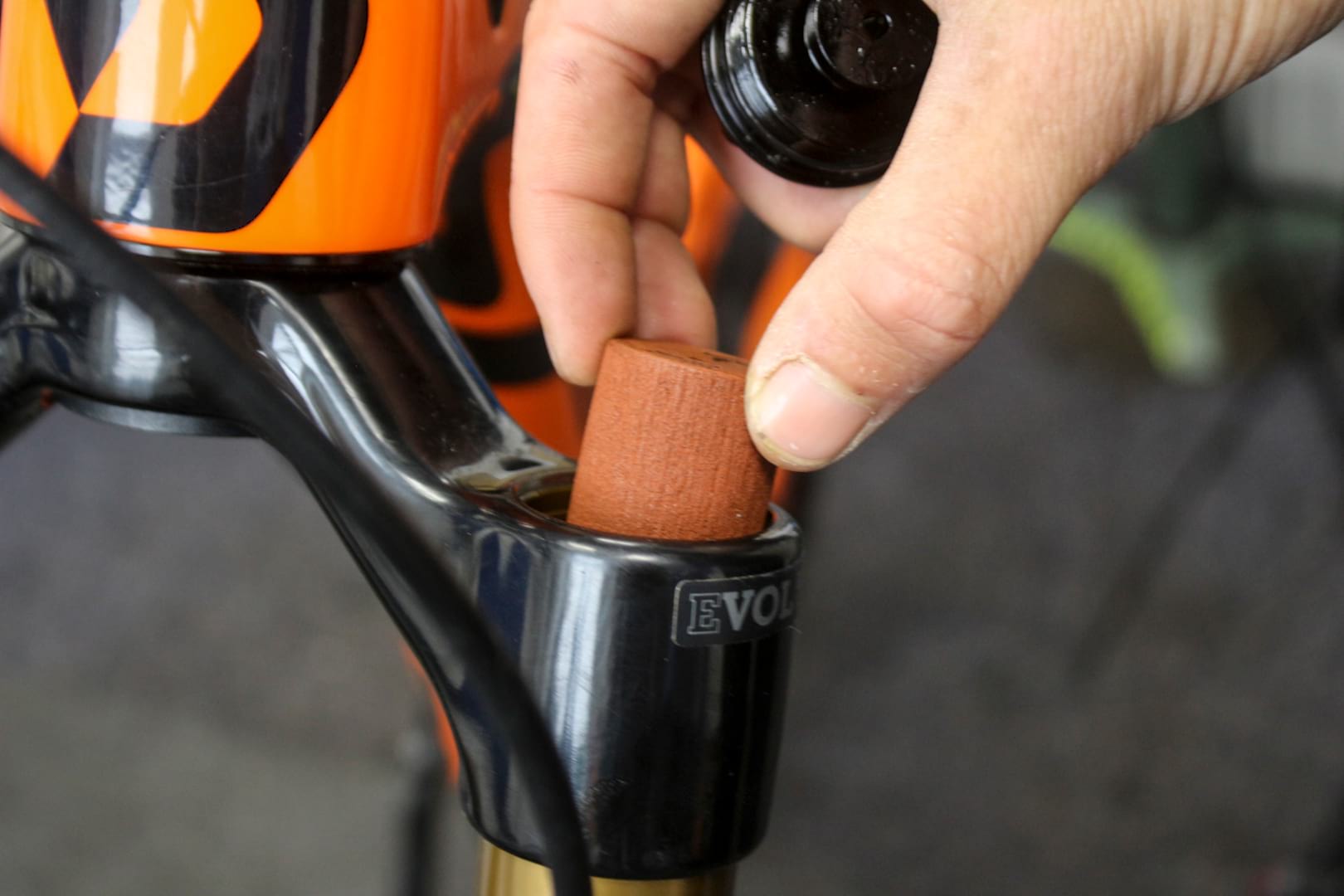
Once I added the Neopos spacer, there was an immediate improvement in sensitivity throughout the travel. The fork felt a little more supple over small and medium-sized bumps, but there was also more sensitivity in the last half of the travel – it was reactive through and beyond the mid-stroke, and the suspension felt more usable deeper into the stroke.
I found this particularly noticeable on fast, repeated hits, where the 36 tracked the terrain more accurately with less spiking when copping sharp impacts, even while already partway through the travel. Previously, the 36 would feel a little choked up in such situations.
The improved rebound consistency and high-speed compliance helps to dissipate smaller vibrations, which has a noticeable effect on comfort at the grips, particularly through braking bumps and on chattery washboard surfaces. Perhaps counterintuitively, the Neopos spacer also allowed me to make use of more of the available travel, even though it had effectively reduced the air spring volume.

With this boost in compliance, I ended up adding air pressure. Even with the higher pressure though, the suspension remained sufficiently smooth and active. However, the reduced sag helped to lift the ride height of the front of the bike, better preserving the bike’s dynamic geometry on steep descents. Thumbs up all round from me.
Are More Neopos Spacers Better?
Not necessarily. Because I was trying to isolate how the Neopos spacer was affecting the feel of the suspension, I typically tested each fork with just a single spacer. However, I did end up trying two spacers in the 170mm travel Fox 36. With two spacers inside, the fork simply became more progressive – just like you would expect from adding more tokens. The general behaviour of the fork didn’t change though.
This turned out to be consistent with Formula’s testing. “If you use more then one Neopos you work on the progression curve exactly as you do with traditional spacers”, Vittorio explained to me. “If you want to work on the air behaviour one Neopos is enough since there’s no difference between one or three. One Neopos is enough to change the behaviour of the air in the volume that you have in the fork.”
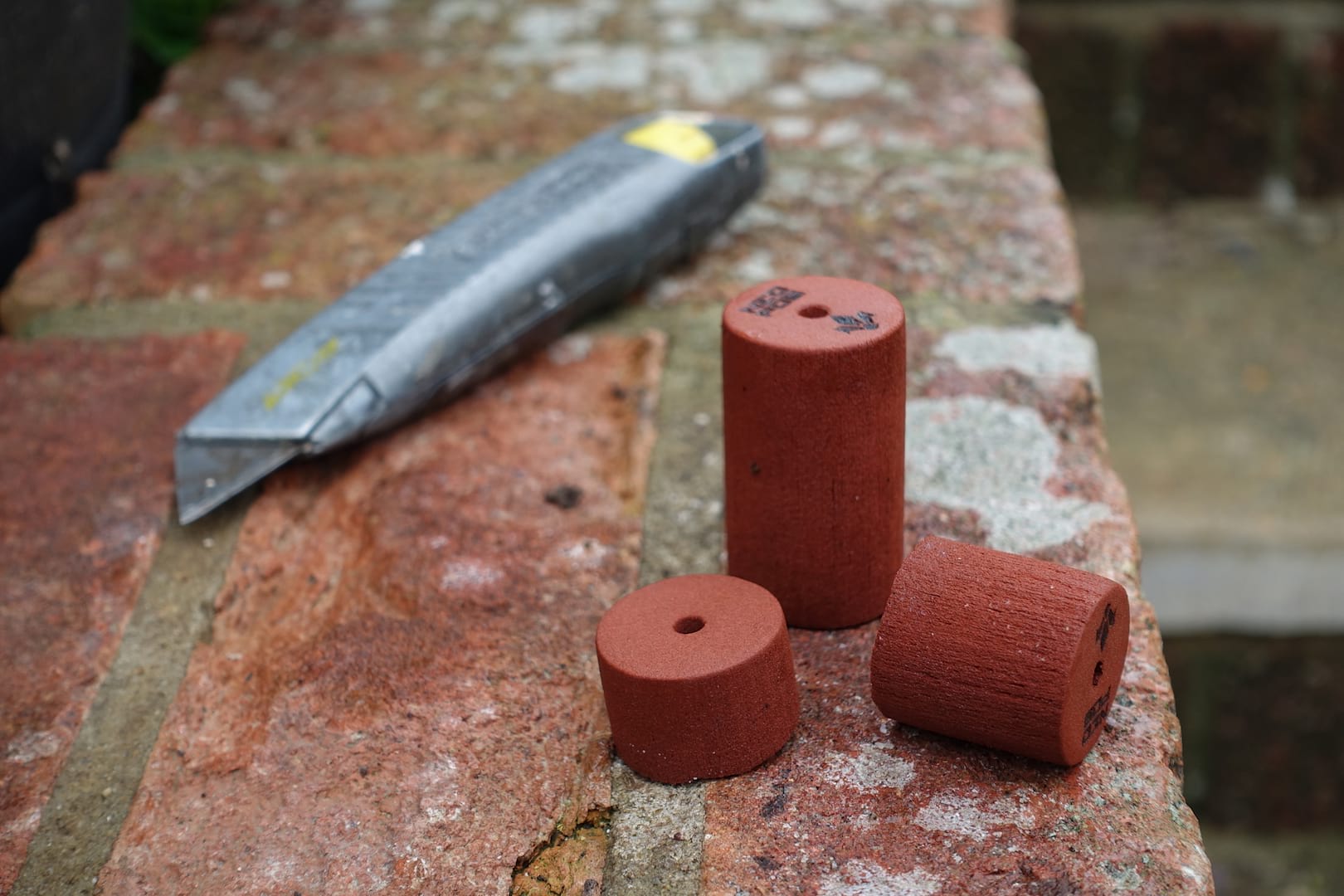
What About Rear Shocks?
Yes, I also tested a Neopos spacer inside a rear shock. Or should I say, I cut a ¼ slice of a spacer and put it inside the tiny Fox Float DPS shock on my Santa Cruz Blur longterm test bike, since that’s really all would fit inside the tiny air can.
There was a touch more progression due to the change in air volume, and I also noticed a small improvement in overall sensitivity. As with the forks though, this improvement is more noticeable on rapid, high speed chatter, but it wasn’t as night and day. I’d hazard a guess that the effect might be more noticeable in a bigger shock on a longer travel bike.
After three weeks of riding the spacer was starting to deteriorate inside the air can. This could have been down to my terrible cutting skills that left a pretty rough surface on the spacer, or it might have been down to the spacer getting physically mushed inside the air can. The spacer wasn’t in too bad condition, but there were a few wayward specks of foam floating about inside the air chamber, which is obviously not good for any of the seals.

On the note of durability, I never had an issue with any of the forks we tested it with – including the Fox 36 that had a Neopos in it for a couple of months of intensive use. It stayed in one piece, with no degradation whatsoever. Perhaps that’s because the 36’s air spring uses grease for lubrication rather than oil? Or maybe its due to the air chamber being much bigger, with less chance of physical wear to the Neopos spacer?
Whatever the reason, it’s worth reiterating that Formula doesn’t recommend using this little guy in anyone else’s forks or shocks. If you do, then do so at your own risk, and make sure you keep a close eye on it.
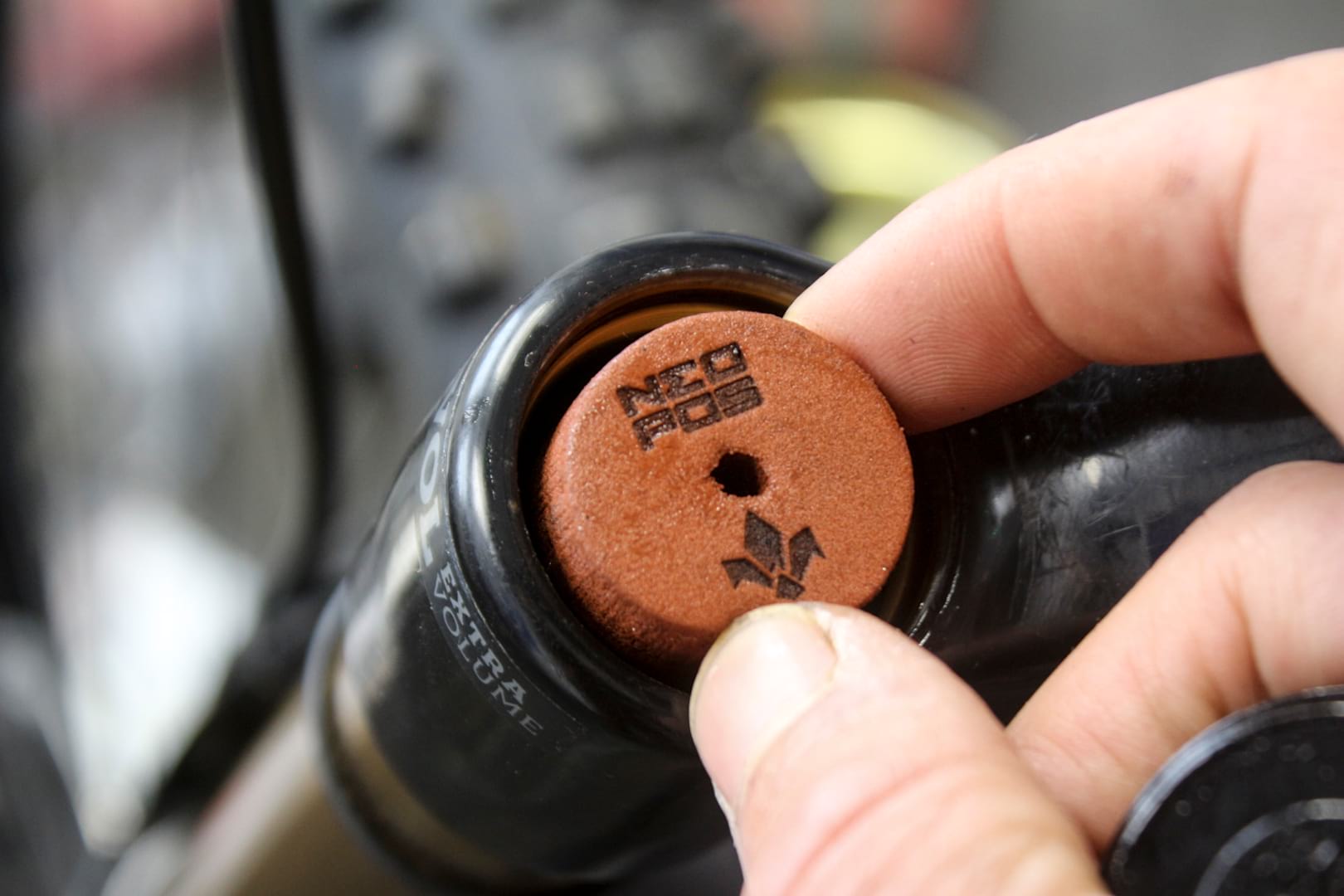
Overall
I’m impressed. The Neopos spacer does what it says it will, and particularly when it comes to smoothing-out of the spring curve in the latter half of the travel. On bigger forks mounted to bigger bikes, it also provides an improvement in sensitivity to high-speed chatter, resulting in a more comfortable and predictable ride.
As such, the Neopos spacer comes highly recommended for those who own a set of Formula forks.
For use with non-Formula forks, our results were more than positive. But as with any aftermarket modification, pursue at your own risk.





I’m sure one of the other sites had them breaking up when used in another fork, probably due to different oils/fluid/grease. Good concept though!
I might have missed this, but did you test the Neopos spacer back to back in the same fork with a rigid spacer of comparable volume at the same air pressure?
Interesting.
On a slightly different note. I really hope that wills relocation across the pond doesn’t stop articles like this. I really enjoy them.
I put one of these in an RLC FIT 34. I was amazed at the improvement in the ride. I thought it may placebo, or I removed it to check. It wasn’t.
BWD, I imagine, assuming the spacer is the uncompressed size of the neopos then the spacered fork would be harsher on small stuff and harsher at the end of the stroke.
@rockthreegozy – That’s right, I believe it was Paul Aston from Pinkbike who had issues with one of the spacers he tested.
@BadlyWiredDog – You bet! Figured I didn’t need to stipulate in the review that I performed back-to-back testing, but yes, I did. Swapping the Neopos spacer with a regular volume spacer and running the fork at the same pressure and damper settings produced a very different ride quality. Much plusher, and much more effective in the last 3rd travel. The behaviour of the air is also slightly different with the Neopos spacer in the air spring, so it takes some experimenting to work out what works best for you. In general, I found adding the Neopos spacer to my existing setup produced the best results. The 34 SC is the exception – I’ve now swapped one stock volume spacer with a Neopos spacer, and to counter the fork’s willingness to use full travel, I’ve bumped the air pressure up about 8psi. Despite the higher pressure, and higher ride height, the fork is still more compliant, which is impressive.
@andybrad – Glad you enjoyed the article! And the plan is to continue with tech articles like this, so we’ll have plenty more coming your way!
@LAT – Cheers for passing on the feedback, and good to hear you’ve had a positive experience!
‘You bet! Figured I didn’t need to stipulate in the review that I performed back-to-back testing, but yes, I did.’
I’d say that was pretty fundamental tbh. Otherwise you’re just testing the effect of a volume spacer, no? Even if it’s a squishy one. So good to know you did just that.
I’m running two in my 150mm Lyrik. Definitely prefer the way they feel to the plastic tokens.
Only thing I’ve noticed is that they sometimes fold over on themselves inside the fork. Not sure if its an issue.
@BadlyWiredDog – Well, it is kind of my job 🙂
@jonswhite – Yes, I have noticed this can happen from time to time. It doesn’t seem to be a problem. Just make sure if you’re trying to remove the spacer, use something that isn’t going to scratch the inside of the stanchions or leave any debris in the air spring. I used the end of a thin, wooden paint brush.
Hi Will, excellent article, just bought some, should arrive in a few days. On my 2017 Pikes do the existing tokens stay and then I add the NeoPos or is a case of swapping one for the other, thnx Paul
@pb2 – Thank you for the kind words, and glad you liked the article!
It takes a bit of experimenting with the Neopos spacer to get the right setting for you.
With each fork I tested, I started by adding the Neopos spacer to the existing setup. From there, I’d play around with air pressures to see how the fork felt, and to measure how much travel I was getting.
Then I’d experiment with removing one of the stock volume spacers while leaving the Neopos in. And again, play around with air pressures and see how much travel you’re using.
One thing to note is that you may need to adjust your rebound damping due to the change in spring rate. I usually sped up the rebound one click with the Neopos spacer fitted.
Hope that helps!
ST Wil.
Cheers Wil (got the spelling right this time 😉 ) your wisdom is appreciated. Just need Herman the German to deliver the bits and then I’m off testing
Why didn’t you try it in a Rockshox fork? I’d be interested how they’d work in a Pike.
@asbrooks – Pretty simple reason – I haven’t had a test bike lately with a Pike on it 🙂 If I do get my hands on a Revelation/Pike/Yari/Lyrik in the near future though, I’ll be dropping one of these into it.
I’ll keep you posted on any further findings mate!
ST Wil.
They work extremely well on 2017 Pike RC, takes a bit of getting used to. Let me explain what I mean, I weigh circa 200lbs with my kit and camelback on. Normal with 100psi with two tokens I would hit the limit somewhere on a ride. By adding one Neopos and dropping the pressure to 95psi everything felt noticeably plusher but when I finished I had only used 60% of the travel and that amazed me. I will need to do more testing but it’s a cost effective upgrade